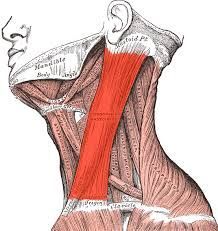Muscle Highlight: The Sternocleidomastoid
When we think of tight neck muscles, most of us immediately imagine the trapezius—the big “cape-like” muscle across the shoulders. But another key player in neck tension is the sternocleidomastoid (SCM), a long, prominent muscle that often gets overlooked until it’s sore. Let’s dive into where it is, what it does, why you might want to get it massaged, and simple ways to stretch it.
Where Is the SCM?
The SCM is a paired muscle on each side of your neck. You can feel it when you turn your head to one side—it’s the rope-like band that pops out from behind your ear down toward your collarbone.

What Does the SCM Do?
The SCM is responsible for several important movements of the head and neck:
- Rotation: Turns your head to the opposite side.
- Flexion: When both SCMs contract together, they help flex the neck forward.
- Lateral flexion: Tilts your head toward the same shoulder.
- Accessory breathing muscle: When you’re short of breath, the SCM can help lift the rib cage slightly.
Because it’s so active in daily movement—and can get overused with poor posture, stress, or excessive screen time—the SCM often becomes tight.
Why Get the SCM Massaged?
Massage of the SCM can help with a variety of issues, including:
- Neck pain and stiffness
- Tension headaches or migraines: the SCM is often a trigger point source for referred pain into the head, behind the eyes, or into the jaw
- Jaw tension or TMJ discomfort
- Forward head posture from desk work or looking at devices
- Stress relief, since neck tension often reflects overall nervous system tension
Targeted massage helps release knots, improves circulation, and restores healthy movement to the neck.
How to Stretch the SCM

Stretching the SCM is simple but powerful. Here are two gentle ways to do it:
Basic Neck Tilt and Turn
- Sit or stand tall.
- Tilt your head to one side, bringing your ear toward your shoulder.
- Gently turn your chin upward toward the ceiling.
- You should feel a lengthening along the front and side of your neck.
- Hold 20–30 seconds, repeat on both sides.
Assisted Stretch
- Sit with shoulders relaxed.
- Place your hand behind your back.
- With the opposite hand, gently tilt your head to the side and slightly back.
- Breathe deeply, and avoid forcing the stretch.
Always move slowly and stop if you feel pinching or sharp pain.
Final Thoughts
The SCM muscle plays a huge role in neck mobility, posture, and even headaches. Massage can be a game-changer for releasing SCM tension and improving overall comfort. Pairing massage with gentle stretching and mindful posture habits will help keep your neck feeling open, relaxed, and pain-free.
Ready to release some neck tension? Book a session and let’s give your sternocleidomastoid muscles some care.
On the Blog



